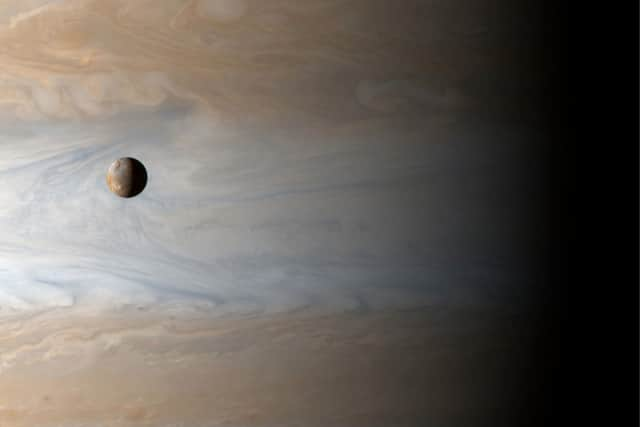Jupiter tonight: where is the planet in the sky, is it close, is it visible from the UK - how to see moons
and live on Freeview channel 276
Extraordinary views of Jupiter are on the way this week as the gas giant reaches its closest approach to Earth in 59 years.
The largest planet in the solar system reached ‘opposition’ yesterday evening (26 September), which is when the gas giant is positioned directly opposite the Sun, as seen from the point of view of the Earth.
Advertisement
Hide AdAdvertisement
Hide AdBut how exactly can you observe the planet for yourself, when is the best time to see it, and where in the night sky will you need to look?
Here is everything you need to know.
How ‘close’ will Jupiter be?
Jupiter at opposition occurs roughly every 13 months, but because the planets do not orbit the sun in complete circles, they pass each other at varied distances, making Jupiter’s current proximity to Earth unusual.
On the day of its opposition, Jupiter is not always exactly at its closest point to Earth. However, in 2022, Jupiter’s opposition to the sun and closest approach to Earth occur on the same day.
That’s because Jupiter’s opposition occurs so close to its perihelion - the planet’s closest point to the sun in its 12-year orbit, which will occur on 21 January 2023.
Advertisement
Hide AdAdvertisement
Hide AdSince Jupiter is ‘close’ to the sun and the Earth travels between the two in space, this results in a close opposition.
Though, to describe the planet as ‘close’ to Earth is a bit of an overstatement: even at its nearest, Jupiter is still situated a staggering 367 million miles away from our home.
At its furthest, Jupiter is around 600 miles out into space from our position, and the difference in distance will be noticeable from Earth; the positioning will make the largest planet in the solar system appear larger and brighter in the night sky.


When is the best time to see it?
Jupiter will be at ‘opposition’, which means it is positioned directly opposite the Sun in space, as seen from the point of view of the Earth.
Advertisement
Hide AdAdvertisement
Hide AdThis means that as Jupiter rises in the east, the sun will be setting in the west. The best time to see the giant planet was at sunset on the evening of 26 September.
Although Monday saw the ‘close’ approach at its peak, the days surrounding that date will also show Jupiter at close quarters too - so keep an eye to the evening skies throughout this week.
How can I see it?
According to NASA experts, the ideal place to see the celestial event is somewhere high, dark and dry.
You’ll want to look east and low towards the horizon; if you bear in mind that ‘opposition’ means when a planetary body or object is directly opposite our Sun when viewed from the point of view of the Earth, that should give you a good idea of where to cast your gaze.
Advertisement
Hide AdAdvertisement
Hide AdThe planet will be easily visible with the naked eye - Jupiter is likely to be the brightest object in the sky, not including the moon - and you will have no need for binoculars to see it.
However, more advanced binoculars - and many entry-level hobbyist telescopes - will offer improved views, and you may even be able to spot the largest of Jupiter’s 80 moons orbiting around it, and the famous Great Red Spot.
Of course, you’ll need clear skies to get the best views of the night sky, and with the British weather famously temperamental, that’s no guarantee.
Last month, the James Webb Space Telescope showed Jupiter at its best in a series of fresh photos.
Advertisement
Hide AdAdvertisement
Hide AdThe telescope took the photos in July, capturing unprecedented views of Jupiter’s northern and southern lights, and swirling polar haze.
Jupiter’s Great Red Spot, a storm big enough to swallow Earth, sood out brightly alongside countless smaller storms.
One wide-field picture was particularly dramatic, showing the faint rings around the planet, as well as two tiny moons against a glittering background of galaxies.
“We’ve never seen Jupiter like this. It’s all quite incredible,” planetary astronomer Imke de Pater, of the University of California, Berkeley, said in a statement.
Advertisement
Hide AdAdvertisement
Hide AdNasa and the European Space Agency’s £8.5 billion successor to the Hubble Space Telescope rocketed away at the end of last year and has been observing the cosmos in the infrared since summer.
Scientists hope to behold the dawn of the universe with Webb, peering all the way back to when the first stars and galaxies were forming 13.7 billion years ago. The observatory is positioned one million miles from Earth.
Comment Guidelines
National World encourages reader discussion on our stories. User feedback, insights and back-and-forth exchanges add a rich layer of context to reporting. Please review our Community Guidelines before commenting.
